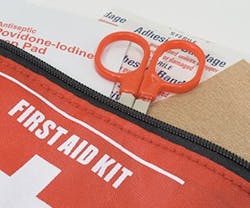Sooner or later, an occupant will experience a medical crisis in your building – a heart attack, an allergic reaction, maybe loss of consciousness. Are you willing to leave it up to chance that someone with first aid training will be nearby?
While many organizations regularly think about workplace safety in terms of accidents and injuries, medical situations may escape notice. Head off liability issues by anticipating medical complications in your emergency response plan and institute a first aid training program.
Rely on Incident Management
While you can’t prevent a medical emergency, you can nonetheless be proactive about your response to them. If you don’t already have one in place, the first step is to implement an incident management program.
You can use the same reporting procedures for medical assists as you use with workplace injuries, documenting every time 911 is called or first aid is administered. You can then use this data to refine your emergency response plan.
“Identifying potential medical emergencies is no different than conducting a security assessment,” says Sean Ahrens, global practice director for security consulting and design services with Aon Global Risk Consulting. “Start by looking at previous incidences and target your training and policies accordingly.”
Any incident should also be communicated to upper management. Company leadership should be aware of the number of medical emergencies that occur each year, a figure many organizations fail to record or act on.
You can also use the information to help justify necessary investments in your emergency preparedness program, notes Ahrens, such as first aid training, updating or expanding emergency kits, or adding security officers.
Prioritize Training
When was the last time you took a CPR class? Have you ever used a defibrillator before? Do you know how to stabilize someone during a seizure?
Until EMS arrives, someone in your building will become a de facto first responder for a coworker having a health crisis. Whether this person is a colleague or a security officer, having the right first aid training is essential.
Particularly under pressure, first responders may become frazzled if they don’t feel comfortable administrating first aid. According to OSHA, they need to have an understanding of how stress, the fear of infection, and panic can interfere with performance and what to do to overcome barriers to action.
“Defibrillators, for example, are fairly straightforward to use. But under duress, you still need to know where the unit is located and have the confidence to use it properly,” says Ahrens. “The only way people can overcome hesitation is to go through practical training.”
Key training courses might include:
- CPR
- Defibrillator use (AED)
- Heimlich maneuver
- Seizure assistance
- Burn response
- EpiPen injections (for anaphylaxis)
- Sports safety
- Bloodborne pathogens
Per OSHA, training should also include an understanding of universal precautions and body substance isolation. Having access to personal protective equipment is paramount, as is proper management of contaminated surfaces and materials.
First aid standards are often updated, so make sure refresher courses are part of your program. Case in point – not everyone is aware that the guidelines for CPR were overhauled in 2010 by the American Heart Association.
Users should follow the C-A-B method: compressions first, then airway and breathing. If administrators are using the old A-B-C method, they could be hindering proper resuscitation.
“The right training can save a person’s life, but the wrong training could put them in more danger than the injury or medical issue itself,” Ahrens cautions.
This is why it’s important not to rely on well-intentioned bystanders who could unwittingly complicate the situation. Determine which individuals are authorized to assist in your response plan and make sure they are properly trained. A logical choice could be floor or department safety managers already tapped for other emergencies.
If you contract security, don’t assume that your officers are prepared or authorized to respond to a medical emergency, says Ahrens. It’s important to clarify security’s role in an incident. Otherwise erroneous assumptions might be made about security’s responsibilities, when they may be limited to calling 911. You should also verify that responding security personnel have the appropriate training to manage the incident.
Because a health emergency can unfold quickly and cause confusion, general first aid education can also be disseminated to occupants so they can recognize a medical crisis and take the appropriate action.
From a liability perspective, your organization should also be familiar with the legal aspects of first-aid care, advises OSHA. Because laws differ by state or even municipality, familiarize yourself with Good Samaritan legislation, consent, assault and battery, abandonment, negligence, and other pertinent regulations.
Never Fear the 911 Call
You’ve known since grade school to pick up the phone and call 911 in case of an emergency. The advice certainly hasn’t changed.
This is particularly important as some medical emergencies can mimic drunkenness, notes Ross Johnson, senior manager of security and continuity planning with Capital Power Corporation and ASIS chair. A person with an altered mental status may need a ride in an ambulance, not in the back of a police car.
Conditions such as a diabetic emergency (insulin shock), a reaction to medication, head injuries, epilepsy, stroke symptoms, and some psychological disorders can cause incoherence in ways that make a person seem intoxicated. Ask for EMS to respond on the off chance they need medical assistance.
“Don’t be shy about calling 911,” stresses Johnson. “It’s never a problem for EMS to get a call and then not be required. The real issue is when help is needed but never asked for.”
Jennie Morton [email protected] is senior editor of BUILDINGS.
About the Author
Jennie Morton
A former BUILDINGS editor, Jennie Morton is a freelance writer specializing in commercial architecture, IoT and proptech.
